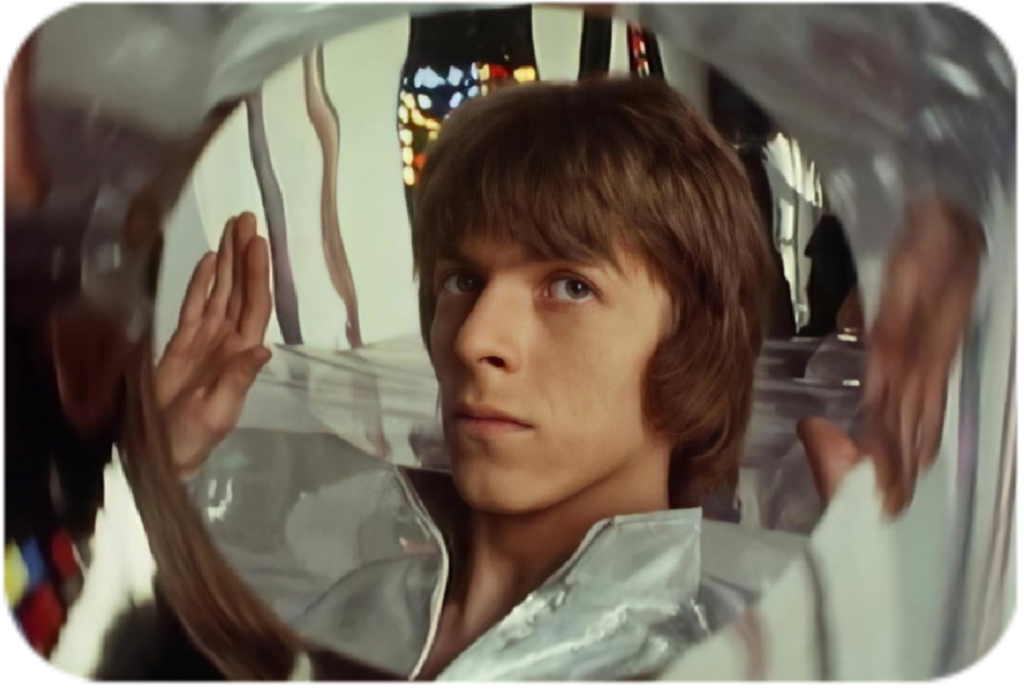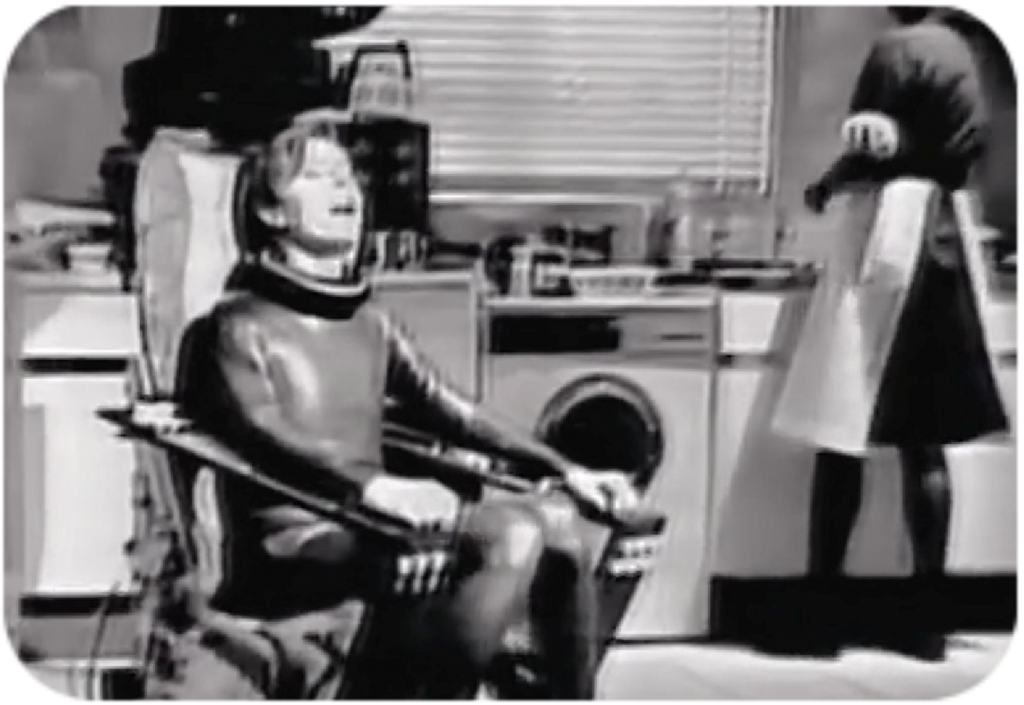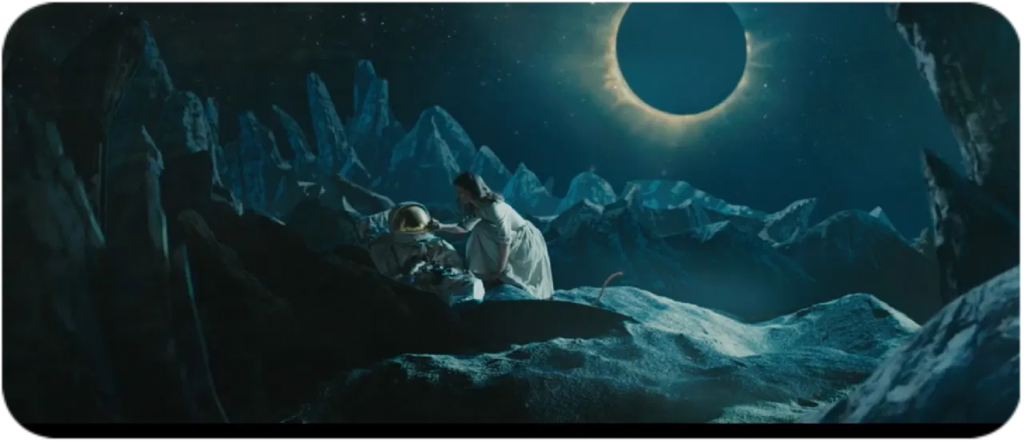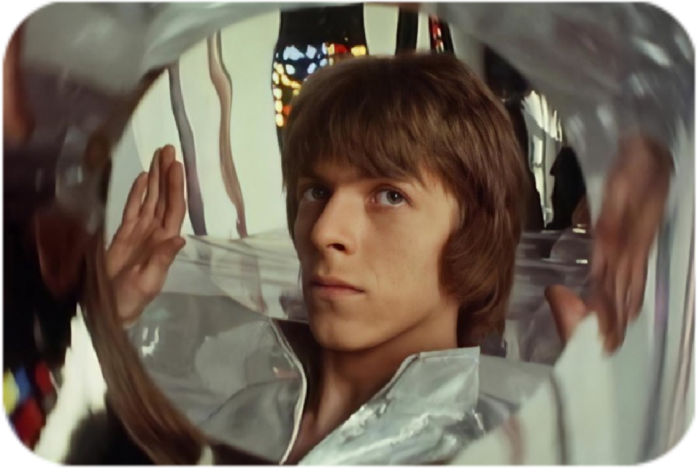by Asia Leonardi for the Carl Kruse Arts Blog
It is 1969, and the young David Jones, better known as David Bowie, begins to ascend the world stage thanks to the launch of his latest single, Space Oddity. Likely influenced by the space race, the tales of Ray Bradbury, and undoubtedly by 2001: A Space Odyssey. The single was supported by two video clips and would have profound influence.
Here we meet Major Tom for the first time: an astronaut readying to leave Earth who communicates with Ground Control. After takeoff, the shuttle (or rather, the Tin Can) soon floats in space. Looking back at earth, Tom sees it blue — “Planet Earth is blue and there is nothing I can do,” a meditation perhaps on abandonment, isolation, and the smallness of humanity compared to the vastness of space. From earth, Ground Control is triumphant, enthusiastically wanting to know everything about Tom and telling him the mission is a success. But Tom loses interest in earth, decides to cut contact while drifting towards the immensity of space, towards the infinite.
There are two versions of the Space Oddity video. The first is from 1969, and is part of the film Love you ‘Till Tuesday (a collection of Bowie’s promotional videos). Bowie plays the parts of both Ground Control and Major Tom, displaying his skill at acting. It is an experimental video, following the dystopian science fiction atmospheres of the 60s. The second version, the one we know as the official one, dates to 1972: Bowie appears with the garments of his new alter ego, the androgynous, histrionic, alien Ziggy Stardust. This time the atmosphere is darker and heavier, fragmented by turns of red and the occasional overlaps of an oscilloscope.

Time passes, Ziggy Stardust gives way to the White Duke. The Spiders from Mars have disbanded, Bowie has crossed the streets of a short dystopian path in Diamond Dogs; drug problems, the contract disputes with agent Tony Defries, as well as the general discomfort caused by the growing celebrity, threw Bowie into a deep crisis.
Perhaps the need to cling to new ideas, to renew his music, his figure, and himself, led him to resurrect in a new song, extending his hand once again to his old alter ego Major Tom: this is the time of Ashes To Ashes. Perhaps the most autobiographical, deep, and poignant track of Bowie’s music trajectory. After years of launching into space, Major Tom, lost in an alien world, halfway to an asylum and to a wasteland, contacts Ground Control. But he isn’t the old Major Tom: he is a character still in the throes of addiction, depression, a glimmer of madness, an uncomfortable person ( “we know Major Tom is a junkie” ), one to be avoided ( “My mama said to get things done, you better not mess with Major Tom” ), inept ( “I never done good things, I never done bad things, I never did anything out of the blue” ). But it is only a reflection of the past that breaks in the condition of this dystopian and introspective present. Bowie abandons Tom in a wasteland, and it will be ten years before the insane astronaut returns to the scene.

In the inimitable masterpiece, certainly not easy to understand, which is 1.Outside, our old Major Tom returns. The concept album, dark and complex, tells the story of the murder of the young Baby Grace Blue at the hand of the artist Minotaur, followed point by point by Nathan Adler’s investigations in a New Oxford Town bordering on dystopia and a materialized paranoia (Nathan Adler writes: “it was art alright, but was it murder?” ). It’s in the track that follows the girl’s last words ( “ … and I think, something is going to be horrid ” ), that with an angry, contemptuous, and explosive fury returns to the stage, Major Tom. The song is Hallo Spaceboy (an interesting pun on the words “Hallow”, “Halo”, and “Hollow”). Tom no longer recognizes his world, nor any other world. In a state of confusion, drowsiness, loss, the astronaut has become a static figure, motionless in various dimensions in which he traveled, he wants to be free, but what is, after all this time, the true meaning of the word “free”? Tom curses those who listen to him: “the moon dust will cover you”. In the live video of the song, played by Bowie and the Pet Shop Boys, a second verse is added: PSB, as Ground Control, say goodbye to Major Tom. The countdown does not work, the circuits are damaged, so bye-bye Tom.
But Major Tom is not dead. He always disobeyed death’s call, reappearing in different scenes in Bowie’s life. The end of the first alter ego of David Bowie coincides with the end of the songwriter himself. We are at the most complex and most difficult to digest movement, more than everything in his path — Blackstar.
Shocking eulogy to himself, the Blackstar album was announced at short notice and released only two days before the death of Bowie. The track that gives the title to the album brings together rhythms and sonorities of jazz with ecstatic interludes, text functions as a long prayer of repetition, litanies, and different quotes to Aleister Crowley. The refrain is evocative, symbolic, and poignant: “Something’s happened on the day he died, Spirit rose a meter and stepped aside, Somebody else took his place and bravely cried: I am a Blackstar “.
The music video narrates the demise of Major Tom. In a desolate planet, dotted with black stars, humanoid creatures find the remains of Tom in an astronaut suit, whose skeleton is crowned with jewels. They make an altar where they revere his skull, while the remains of the skeleton are seen floating in space towards a black star.

Major Tom is the first alter ego of David Bowie and the only one that has never abandoned him, marking his beginning and his end. It remained floating in a forgotten space, metaphorically material, but probably abstract and internalized. Originally, perhaps, embodied the American dream, the exploration of new worlds, which corresponded, paradoxically, to the launch of Bowie in the circle of celebrity, vices, and drugs. Then confused, lost, inept, insane, always hovering between the destruction of himself and a glimmer of sanity which never allows him to gain the awareness of the dimension that he is passing through. There are plenty of wires that connect the evolution of Major Tom to the arc of Bowie’s life, his figure is always a return to the past and a new launch to the future: from the moment when he leaves earth to the moment he fluctuates towards a big, sad and desperate black star.
============
The Carl Kruse Art Blog homepage is here.
Contact: carl AT carlkruse DOT com.
Other articles by Asia Leonardi are on Filippo Brunelleschi, Marina Abramovic, and Lost Architecture.
The blog’s last post was on artist Yury Kharchenko.
Carl Kruse is also at USGBC.

As I write it’s the 40th anniversary of Bowie’s collaboration with QUEEN on the song “Under Pressure,” which is one of my favorite rock songs of all time. Ok, not classic Bowie, nor does it have anything to do with Major Tom, but it is still Bowie, and your post prompted me to post this.
Loe Queen and Bowie.